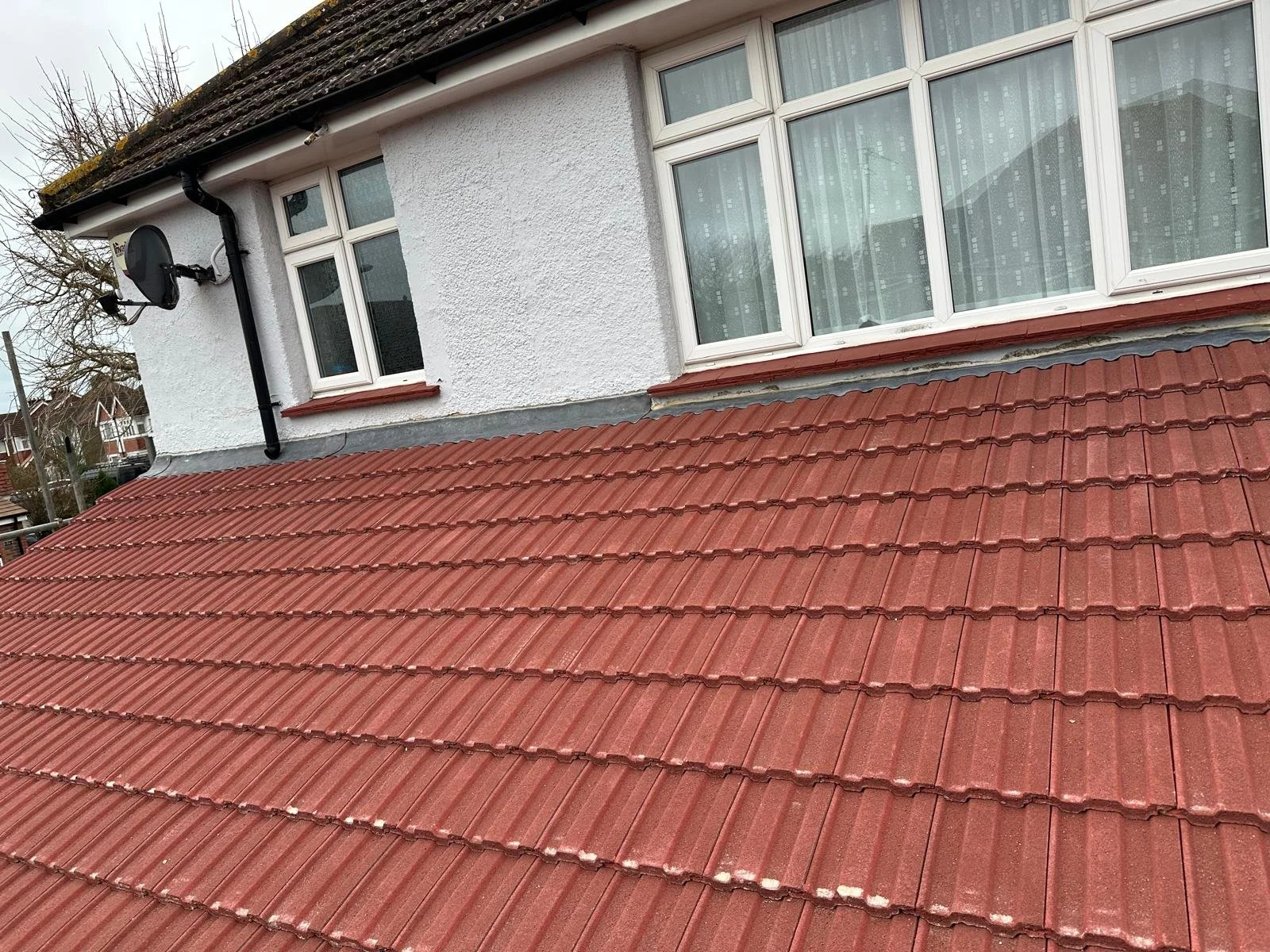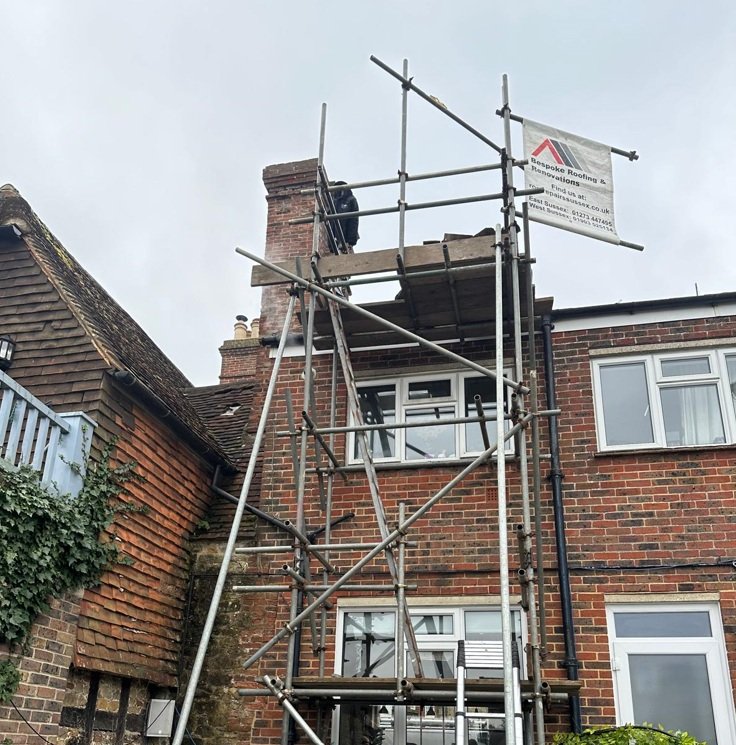Burgess Hill Roofing
We provide all your roofing needs in Burgess Hill. Contact Bespoke Roofing Sussex today for a free, no‑obligation quote on 01444 810086.
About our roofing in Burgess Hill
Bespoke Roofing Sussex provides comprehensive roofing services across Burgess Hill, delivering high-quality workmanship for all types of roof repairs. Our experienced team handles everything from minor tile replacements and ridge repairs to full re-roofs, ensuring each job is carried out efficiently and to industry standards. We work with slate, tile, flat roofs, and fibre enforced liquid rubber installations, using quality materials and proven techniques to extend the life of your roof and protect your property.
Burgess hill roofing quotations
Every quotation we provide in Burgess Hill is scaffold inclusive, so you won’t face unexpected access or safety costs. Including scaffolding in our quotes ensures safe, compliant working conditions and allows our roofers to complete repairs thoroughly and quickly. This transparent approach helps homeowners plan their budgets with confidence and avoids the common hidden charges associated with external work.
We offer drone assessments to inspect roofs accurately and non-invasively. Drone surveys capture high-resolution images and video of hard-to-reach areas, identifying damaged tiles, displaced flashings, clogged gutters, or areas of deterioration that might be missed by ground-level checks. These assessments speed up diagnosis, reduce the need for intrusive inspections, and form part of a detailed report with recommended repairs and clear costings.
As a local, family-run, Checkatrade-registered firm serving Burgess Hill and surrounding areas, we combine two decades of roofing experience with a commitment to reliable service and clear communication. Whether you need an emergency repair, routine maintenance, or a full roof replacement, call Bespoke Roofing Sussex for a free, no-obligation scaffold inclusive quotation and professional drone assessment tailored to your property.
Please see a list below of all types of works covered by Bespoke roofing.
CLICK ON THE PRODUCT FOR YOUR REQUIREMENT
NEW ROOFS Burgess Hill
NEW ROOF LINING Burgess Hill
CHIMNEY REPAIRS Burgess Hill
MOSS REMOVAL Burgess Hill
VALLEY REPLACEMENTS Burgess Hill
HIP, RIDGE AND BONNET TILES Burgess Hill
GRP FLAT ROOFS Burgess Hill
FELT FLAT ROOF Burgess Hill
DOMESTIC GUTTER LINING Burgess Hill
UPVC PLASTICS Burgess Hill
Burgess Hill Roof Lining
Felt lining on a roof becomes worn over time, especially the older non breathable membrane (bitumen based.)
At Bespoke Roofing LTD we are able to offer the roofing service for a new breathable membrane to be installed on your property.
You may not be aware but ventilation cannot be installed without having a breathable membrane lining, as this causes condensation in your roof space which can appear as a leak!
I would recommend this service to any client who's roof tiles are in good condition but the felt underneath has become dilapidated and also those who wish to install ventilation within their roof space.
Burgess Hill Chimney repairs.
Chimney stacks are one of the main causes for leaks into an internal property.
The following issues are the most common to identify.
Chimney Pointing - Age plays a significant factor in the state of the mortar on your chimney. Once your mortar is a certain age it will begin to crack and allow water into your internal property.
Chimney Rendering - Once again age is a significant factor in the state of the render on your chimney. If the render begins to crack this will allow water to travel and sit between your brickwork, eventually leading to water penetration.
Chimney Flaunching - The chimney flaunching sometimes known as a coping is the top section of mortar that allows your pots to be bedded correctly, but also is laid to a fall allowing water to travel off the top of your stack.
Chimney Pots & Cowls - Chimney pots and cowls can become cracked with age, and driving rain can also cause ingress of water should a chimney cowl not be installed.
Lead Flashings - Lead on average has a life span of 20-30 years dependent on its grade. Over time lead expands and retracts with heat and can begin to crack and malign.
Burgess Hill Moss Removal.
Moss, algae and lichen build up can be a big problem for homeowners, not only can it hold water on your roof but also once it falls can block guttering and downpipes preventing free flowing water.
There are a few methods in which we are able to offer in order to remove this from your roof.
The first method is a standard dry scrape - manually removing all moss, algae and lichens from your roof.
The second method is to jet wash and seal.
A manual dry scrape is performed first removing all moss, algae and lichens from your roof.
Once all moss is removed a high powered jet wash is performed with an anti fungal wash to all pitched roofing elevations required.
Once dry we use a high quality roofing sealant to aid in prevention of re-growth and ensure that the roof is 100% clean.
Burgess Hill valley repairs/replacements.
There are a few different ways a valley can be installed.
The most common types of valley are tiled valleys, lead valleys and fibreglass valley.
At Bespoke Roofing we are able to offer all of these option but can depend upon the gradient that your valley is positioned.
In most cases we would also change the roof lining a metre either side of the valley so we can be confident that it is completely weathered.
Burgess Hill ridge, hip and bonnet repairs.
Ridge, hip, and bonnet tiles are fundamental materials that form the external structure of your roof.
Ridge and hip lines can be formed using either a mortar mix or a dry ridge system, with bonnet tiles being formed using a mortar mix.
The most common method of laying ridge, hips and bonnets is using a mortar mix, which in time can deteriorate through weathering.
This is one of our most common repairs as the mortar begins to age well before the tile itself in most cases.
The ridge, hip and bonnet tiles can also deteriorate through age and we also offer the service to replace the tile itself depending on its condition.
Another common roofing issue is through storm damage where tiles can be stripped from the roof in high winds, and therefore require replacing - mainly through insurance.
We at Bespoke Roofing offer all types of repairs, from full ridge, bonnet and hip lines to single tile replacements.
Burgess Hill GRP roofing
Flat roofs can be a real problem in Burgess Hill when they have aged, particularly on the south coast and where high winds and rain can cause severe damage.
Under these conditions there is a very high chance they can crack and cause leaks - a big problem for home owners.
As a business, we provide a service that not only prevents this kind of problem but one we are confident and happy we will not be coming back to once work in Burgess Hill is complete.
Flat roofs can be a real problem when they have aged, particularly on the south coast and where high winds and rain can cause severe damage.
Under these conditions there is a very high chance they can crack and cause leaks - a big problem for home owners.
As a business, we provide a service that not only prevents this kind of problem but one we are confident and happy we will not be coming back to once work is complete.
Burgess Hill Roofing heritage
Roofing in Burgess Hill has a rich history that reflects the architectural evolution of the area, with significant developments dating back to the medieval period. The town, which became more prominent in the 19th century, is marked by an array of roofing styles ranging from thatched cottages to the more modern slate roofs.
Chapel Land Farmhouse, an architectural gem within Burgess Hill, provides a glimpse into the historical roofing practices of the region. This farmhouse, believed to date back to the 17th century, has a distinctively steep pitched roof that was commonly used in that era. Typically constructed from locally sourced materials, the roofing would often consist of handmade clay tiles or thatched straw, showcasing the craftsmanship of the time.
As Burgess Hill transitioned through the Industrial Revolution, roofing styles began to change in response to the growing population and industrial activities. The use of slate became more widespread, allowing for more durable and weather-resistant roofs. This shift was inspired partly by the nearby slate quarries, which made it an accessible material for local builders.
In the 20th century, post-war housing developments introduced modern roofing methods and materials. The introduction of new technologies and materials, such as concrete tiles and synthetic options, offered residents a wide range of choices while also improving the longevity and performance of roofs.
Today, roofing in Burgess Hill, including structures like Chapel Land Farmhouse, continues to reflect both historical significance and modern advancements. Renovations and restorations of such historic properties adhere to preservation standards, ensuring that the original charm and character are maintained while upgrading the roof for enhanced durability and performance. As such, the evolution of roofing in Burgess Hill serves not only as a testament to the region’s architectural heritage but also highlights the balance between history and modernity in contemporary residential design.










